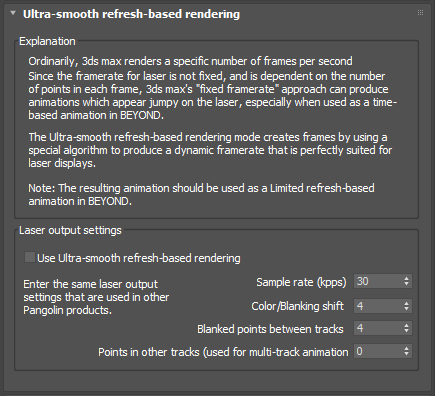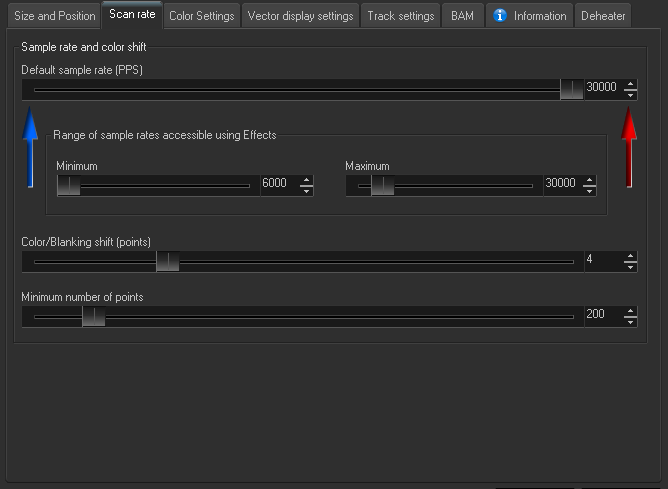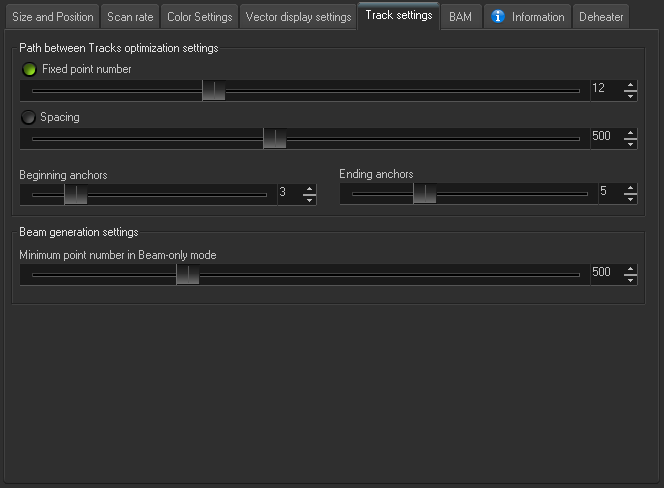Table of Contents
Renderer: Ultra-smooth refresh-based rendering
3ds Max was designed to produce “time based” animations. That is, it produces animations based on a fixed number of frames per second. While this works wonderfully for film or video, this is less than perfect for laser display. For this reason, Lasershow Converter MAX includes a special rendering method called Ultra-smooth refresh-based rendering.

Timing factors for laser frames
Since laser projectors are based on mechanical scanners, the frame rate of laser displays is almost never fixed – it is continuously variable. It depends on the sample rate (in points per second) and the number of points in each frame, among other factors. Because of this, if you playback an animation produced by a time-based tool like 3ds Max in laser, you will typically see a relatively jumpy or choppy looking animation, especially if this animation is played back as a Time-based animation in BEYOND. On the other hand, if you play back the same animation as a refresh-based animation, it will look smooth, but unfortunately the timing of the scene will not correspond to the original timing in 3ds Max.
The reason is that unless you set the Minimum Points setting to a fairly high number, and also ensure that none of your frames exceed that number of points, each frame that Lasershow Converter MAX creates will have a different number of points. With each frame having a different number of points, there is no way to produce a smooth time-based animation and there is also no way to preserve the original scene timing for a refresh-based animation.
How to get the smoothest playback
Lasershow Converter MAX incorporates a special rendering method called “Ultra-smooth refresh-based rendering”. When you use this method, Lasershow Converter MAX uses a special algorithm that does not generate a fixed number of frames per second. Instead, it generates a variable number of frames per second based on the number of points in each frame, and also based on the Sample rate, Color/Blanking shift and Blanked points between tracks settings.
To use the Ultra-smooth refresh-based rendering method, you first indicate your Sample rate, Color/Blanking shift and Blanked points between tracks settings in the panel. You should enter the same numbers as in the Projector Settings dialog box in BEYOND. The Sample rate and Color Shift are on the “Scan rate” tab. The Blanked points between tracks is implied on the “Track Settings” tab.


Optional "Points in other tracks" parameter
Ordinarily when you playback animations rendered with Lasershow Converter MAX, they would be the only thing being output at the time. In other words, you would ordinarily use these animations on a single track in BEYOND. Also, you can specify a number of points that will be in other tracks. This would be helpful if you wanted to have another track (or tracks) being output at the same time as a track with LCMax-rendered material. If this is the case, enter the average number of points found in the other frames in the “Points in other tracks” text box. For example, if you have a BEYOND scene with two active tracks – one being the track with LCMax-rendered material, and a second track with normal laser frames (or other LCMax-rendered material), and if the average point count in the frames on the second track is 1000 points, you would enter “1000” in this text box.
Performing the ultra-smooth rendering
Once these settings are entered, you can tell Lasershow Converter Max to use Ultrasmooth Rendering by checking the box.

Important considerations
There are a few important things to keep in mind when using Ultra-smooth refresh-based rendering.
- Ultra-smooth refresh-based rendering can only be done for the entire Active Time Segment. It is not possible to render individual frames or a selected range of frames using Ultra-smooth refresh-based rendering. Therefore it makes the most sense if you perform Ultrasmooth Refresh-based Rendering as the very last step in your laser show creation process. While you are working on the 3ds Max scene, it makes the most sense to render only individual frames or parts of the timeline, using the standard 3ds Max rendering dialog.
- Lasershow Converter MAX will create an animation that has exactly the same timing and length of time in the 3ds Max scene. Therefore you should design your 3ds Max scene with the ultimate show timing in mind.
- Once you have rendered a scene using Ultra-smooth refresh-based rendering, you can view the resulting animation in 3ds Max using the time slider or the Play button, but you can not re-render individual frames or a selected range of frames. This is another reason why it makes the most sense to use Ultra-smooth refresh-based rendering as the last thing you do before using the animation in BEYOND.